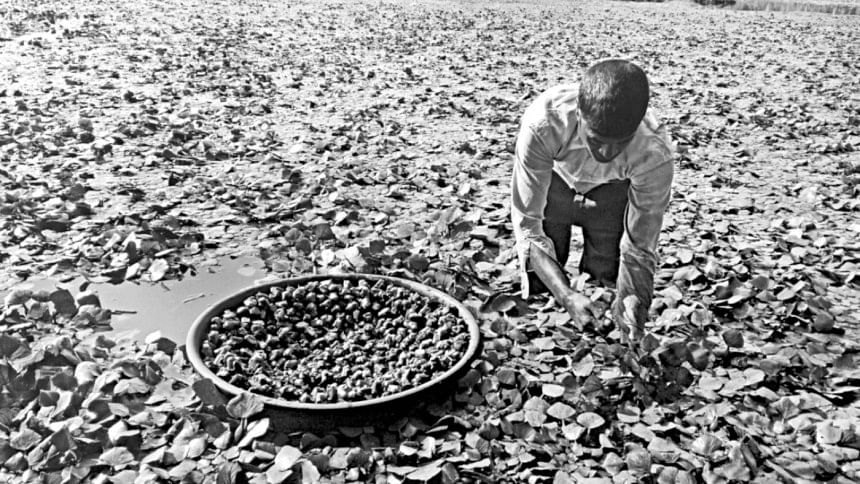Water chestnut brings smile to farmers in two N-districts

In the muddy marshlands of the north locals rely on a secret treasure that brings handsome profits to struggling families. The water chestnut, locally called 'paniphal' is not actually a nut but an aquatic vegetable: a type of grass-like sedge that produces edible corns. An advantage of water chestnut cultivation is that it grows in wetlands, an environment unsuited to other crops.
"I cultivated water chestnuts on 1.5 bighas of land," says Habibur Rahman, 40, a farmer from Borobhita village in Natore Sadar upazila. "It only cost me Tk 1,000 for the crop, but already I have sold water chestnuts worth more than Tk 12,000."
The land he used was traditionally waterlogged and fallow during the Boro season from July to November. "But now we make a handsome profit from this wasteland. It's our only income source during the Monga season," he explains, referring to the traditional annual season of famine in the country's north. "There is no other work to do during the rainy season so we rely on picking and selling water chestnuts for our livelihood."
Hazrat Ali, 38, another farmer from the same village, says he has been growing water chestnuts for twenty years. "I grew water chestnuts on five bighas this year, with a production cost of Tk 15,000. I will sell the harvest for up to Tk 65,000."
"Economically, we really struggle," says Parvez Ali, 28, a farmer from Diyarvitua area, also in Natore sadar upazila. "In the rainy season, the water chestnut is our only hope."
"To get such a good profit from otherwise unusable land makes us very happy," says Mohammad Ali, a farmer from Kanpara village in Naogaon's Manda upazila.
Azahar Ali, a farmer of Paroil village under the Manda upazila of Naogaon said, "I spent Tk. 6000 only to cultivate water chestnut on one bigha and will sell the produce for Tk. 22,000 to 24,000 this season."
Mohammad Ali another farmer of Kanpara village of the same upazila said, "We are very happy because we are getting good profit from the wasteland which was unused for about six to eight months of a year."
Mohammad Ali a farmer of Naogaon Sadar upazila said, there is a nearby market where they send the water chestnuts. Often the wholesalers come to the farming area to collect water chestnuts.
Abdur Razzak, a wholesaler of Natore said, "I bought each maund for Tk. 400 to Tk. 600 from the farmers and will sell each at Tk. 1,000 to Tk. 1400. So, the profit is Tk. 600 to Tk. 800 per maund."
Satyabrata Saha, DD of Naogaon Department of Agriculture Extension (DAE), said, "Last year in Naogaon district farmers cultivated on 10 hectares of land. This year, the farm area will increase up to 18 hectares." We are inspiring the farmers because it is very profitable and the wastelands are becoming useful also.
D. Saiful Alam, upazila agriculture officer (UAO) of Natore Sadar, said, water chestnut is an adaptation concern climate change crops. Usually the comparatively less waterlogged lands are being unused from July to October. But if they cultivate water chestnut they can get profit easily.
According the DAE of farmers are cultivating water chestnut in 6 hectares of land in Natore and 15 hectares in Naogaon district while the temporary wasteland is 8 hectares in Natore and 55 hectares in Naogaon.

 For all latest news, follow The Daily Star's Google News channel.
For all latest news, follow The Daily Star's Google News channel. 



Comments